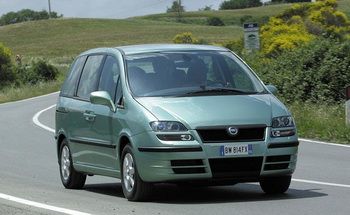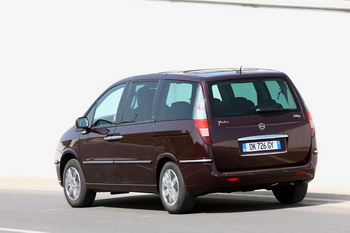
 |
|
The
current-generation Fiat Ulysse (top) and
Lancia Phedra (bottom) MPVs have seen their
sales fade away in recent years as European
customers downsize and these two models are
now set to be phased out. |
|
|
|
Fiat
has revealed this week that it will exit the
joint minivan project it has undertaken with PSA
Peugeot- CitroŽn since 1994, discontinuing
production of the Fiat Ulysse and its rebadged
and more upmarket targeted sister, the Lancia
Phedra. Sales of these two models have gradually
slowed down in Italy and are almost non-existent
now elsewhere, and coupled to the trend of
European car buyers downsizing the vehicles they
purchase plus the recent acquisition of a stake
in the Chrysler Group which is already strong
positioned with technology in this market
segment, it has made the project redundant.
The Sevel joint
venture between Fiat and PSA sees a mix of cars and light
commercial vehicles built for the Fiat and Lancia brand on
the one hand and PSAs Peugeot and CitroŽn on the other at
factories in Italy and France. The MPVs that Fiat is now
discontinuing are built at the Sevel Nord plant near Lille
and use mostly PSA underpinnings and engines.
The project
kicked off in 1994 when the Fiat Ulysse and Lancia Zeta
entered production, along with two similarly-styled MPVs
branded by Peugeot and CitroŽn. They were initially powered
by a range of PSA engines, two 8V 1998cc petrol units
(normally aspirated with 121bhp and turbocharged with 147
bhp) a 1905cc diesel (92 bhp) and a 2088cc diesel (109 bhp,
later with 12 valves). The latter two engines were later
replaced by a 1997cc JTD diesel with common rail and
producing 109 bhp, whilst a 1998cc 16V unit was also added.
The Ulysse and Zeta were built in France at the factory
operated by Sevel, the company jointly established by Fiat
and PSA.
A relatively
boxy design, the Ulysse and Zeta were aerodynamically
optimised to reduce the internal wind noise, whilst having a
light interior due to the large glass area. The dashboard
was also an interesting design for the time and included a
high mounted gearstick. The MPVs would seat either five,
seven or eight people depending on the specified option,
whilst the two rearmost rows of seats could be removed to
give a flat floor area for carrying bulky loads. There was
also an option for swivelling front seats which, together
with the table formed by the folding centre rear seat, meant
a comfortable 'room' could be created. A large sliding door
was provided on each side of the rear which greatly eased
entry to the rear seat rows, whilst passage from the front
to the rear was also possible without opening the doors
thanks to the dash mounted gearshift.
Air conditioning
(or optional climate control) included outlets in the rear
compartment via underfloor ducts, and a double sunroof could
also be specified. Mechanically the Ulysse and Zeta were
quite conventional, with McPherson struts at the front and a
trailing beam at the rear. Other features included ABS
(standard on some models), power steering, twin airbags,
side impact bars and a host of other details designed for
both safety and comfort. The Zeta was Lanciaís first ever
people carrier (or MPV) and this version was aimed at a more
luxurious market than the Ulysse as befitted the Lancia
name. A high level of trim and equipment was standard,
including ABS, and electric everything.
All new, second
generation Ulysse and Zeta models (with the Lancia now being
called the Phedra) were released at the 2002 Geneva Motor
Show. These models were again the result of a joint venture
with PSA but they had grown in size from the earlier version
while also gaining new features. The two rear doors were
available with electric opening if required while advances
in interior design saw various storage options including 3
closed and 1 open compartments, 11 glass/can holders, 4
bottle holders, a centre console coolbox, 4 compartments for
maps/magazines, 2 under-seat drawers, a rubbish bin and an
umbrella holder. A bizone climate control system also
offered separate vents for the rear passengers (with their
own controls in some versions), whilst an active carbon
filter tried to keep out most of the pollution in the
atmosphere.
The engines for
the new models comprised of two petrol units, a 2.0-litre
16V (136 bhp) and a 3.0-litre V6 (204 bhp) and two JTD
diesels, a 2.0-litre 16V (109 bhp) and a 2.2-litre 16V (128
bhp), both with turbocharging and common rail direct
injection. All the engines bar the 2.2 JTD were available
with a four-speed automatic gearbox, whilst only the V6
could not be purchased with a five-speed manual. The
suspension continued the layout of the earlier model, with
MacPherson struts at the front and a torsion beam at the
rear. Safety featured highly on the new generation model
vehicle, with six airbags, ABS with EBD (Electronic
Brakeforce Distribution), ASR (wheelspin control) and ESP
(Electronic stability control). Xenon headlights provided
for safer night-time driving, Isofix attachments allowed for
child-seat fixing, and electric safety locks were provided
on all doors.
|